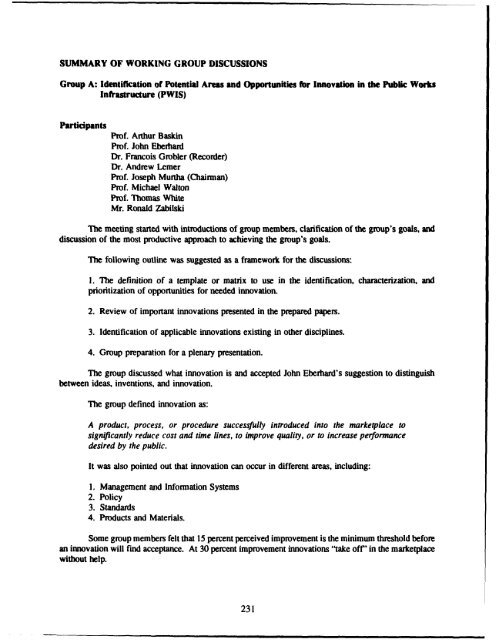Challenges and Opportunities for Innovation in the Public Works ...
Challenges and Opportunities for Innovation in the Public Works ...
Challenges and Opportunities for Innovation in the Public Works ...
You also want an ePaper? Increase the reach of your titles
YUMPU automatically turns print PDFs into web optimized ePapers that Google loves.
SUMMARY OF WORKING GROUP DISCUSSIONS<br />
Group A: Identification of Potential Areas <strong>and</strong> <strong>Opportunities</strong> <strong>for</strong> <strong>Innovation</strong> <strong>in</strong> <strong>the</strong> <strong>Public</strong> <strong>Works</strong><br />
Infrastructure (PWIS)<br />
Participants<br />
Prof. Arthur Bask<strong>in</strong><br />
Prof. John Eberhard<br />
Dr. Francois Grobler (Recorder)<br />
Dr. Andrew Lemer<br />
Prof. Joseph Murtha (Chairman)<br />
Prof. Michael Walton<br />
Prof. Thomas White<br />
Mr. Ronald Zabilski<br />
The meet<strong>in</strong>g started with <strong>in</strong>troductions of group members, clarification of <strong>the</strong> group's goals, <strong>and</strong><br />
discussion of <strong>the</strong> most productive approach to achiev<strong>in</strong>g <strong>the</strong> group's goals.<br />
The follow<strong>in</strong>g outl<strong>in</strong>e was suggested as a framework <strong>for</strong> <strong>the</strong> discussions:<br />
1. The def<strong>in</strong>ition of a template or matrix to use <strong>in</strong> <strong>the</strong> identification, characterization, <strong>and</strong><br />
prioritization of opportunities <strong>for</strong> needed <strong>in</strong>novation.<br />
2. Review of important <strong>in</strong>novations presented <strong>in</strong> <strong>the</strong> prepared papers.<br />
3. Identification of applicable <strong>in</strong>novations exist<strong>in</strong>g <strong>in</strong> o<strong>the</strong>r discipl<strong>in</strong>es.<br />
4. Group preparation <strong>for</strong> a plenary presentation.<br />
The group discussed what <strong>in</strong>novation is <strong>and</strong> accepted John Eberhard's suggestion to dist<strong>in</strong>guish<br />
between ideas, <strong>in</strong>ventions, <strong>and</strong> <strong>in</strong>novation.<br />
The group def<strong>in</strong>ed <strong>in</strong>novation as:<br />
A product, process, or procedure successfully <strong>in</strong>troduced <strong>in</strong>to <strong>the</strong> marketplace to<br />
significantly reduce cost <strong>and</strong> time l<strong>in</strong>es, to improve quality, or to <strong>in</strong>crease per<strong>for</strong>mance<br />
desired by <strong>the</strong> public.<br />
It was also po<strong>in</strong>ted out that <strong>in</strong>novation can occur <strong>in</strong> different areas, <strong>in</strong>clud<strong>in</strong>g:<br />
I. Management <strong>and</strong> In<strong>for</strong>mation Systems<br />
2. Policy<br />
3. St<strong>and</strong>ards<br />
4. Products <strong>and</strong> Materials.<br />
Some group members felt that 15 percent perceived improvement is <strong>the</strong> m<strong>in</strong>imum threshold be<strong>for</strong>e<br />
an <strong>in</strong>novation will f<strong>in</strong>d acceptance. At 30 percent improvement <strong>in</strong>novations "take off" <strong>in</strong> <strong>the</strong> marketplace<br />
without help.<br />
231







